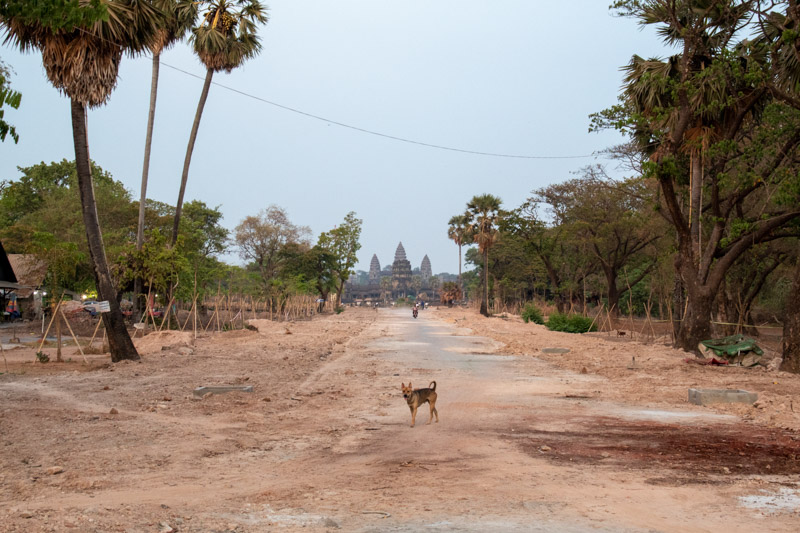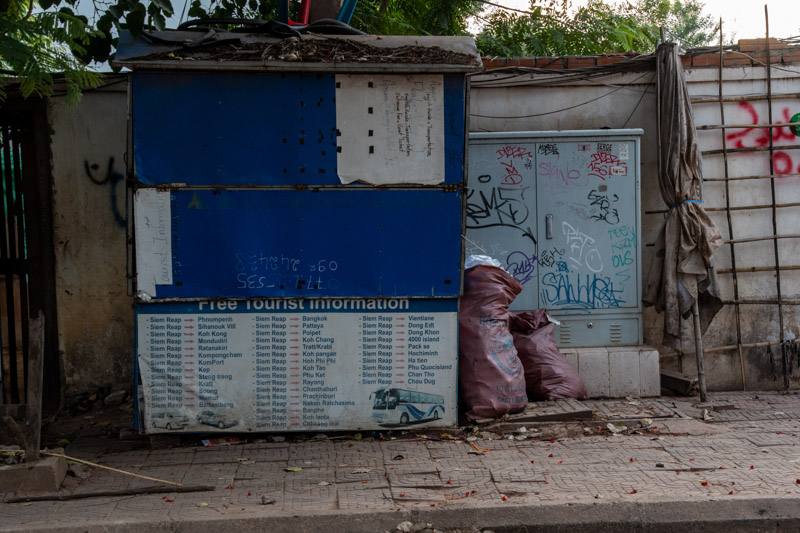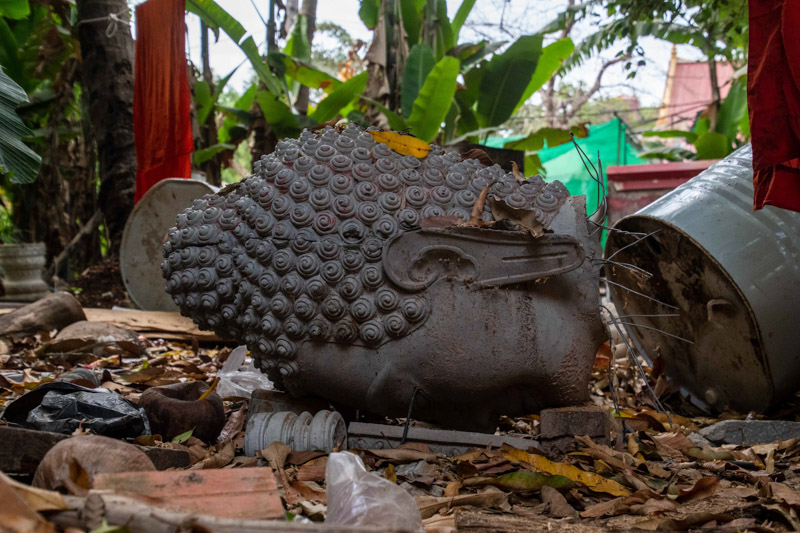The pandemic at Angkor’s doorsteps

It was like a kind of disbelief at first, then astonishment, mixed with growing anguish. The emergence and uncontrolled spread of a new respiratory disease came like a bombshell. Especially since the country of origin of this virus then provided the vast majority of tourists thronging the city. Located just a few kilometers away from Angkor Wat, Siem Reap, aka “Temple Town”, derives most of its incomes from tourism: each year, more than 2 million visitors come to admire an archaeological park reaching nearly 200 monuments.
Vacationers left the area overnight, suddenly revealing the deep vulnerability of an economy particularly dependent on tourism. This financial windfall, which represents a third of the country’s GDP, occupies an even larger part here. Faced with the succession of worrying news, it quickly became clear that the crisis was going to take hold, plunging thousands of households into great precariousness. A strange atmosphere took hold of the city which, once teeming with activity, found itself abandoned, shocked to be deserted in such a way.
The hopeful Year of the Rat marks the start of a never-ending nightmare.
Streets desperately empty, curtains drawn, windows down, displaying pathetic signs adorned with a few words of apology. Signs that will gradually be replaced by “Business for rent” or “for sale”. Many of these businesses will not recover from the continuing crisis, some having celebrated their inauguration one or two weeks before the pandemic. Already highly competitive, the hospitality sector can only count now on local customers. Unfortunately, this is mostly insufficient for most of them.
Travel agencies, bus companies, tourist guides and other service providers also had to face the situation: from April / May 2020, the borders with neighboring countries have been closed and still remain.

With a 99% drop in attendance from the first few months, the Angkor temples show a very different face from what we were used to. No more buses pouring out their flood of tourists, no more on-the-run-tours punctuated by Babelian commentaries and photographic spots stormed by from the early hours of the day. Goodbye unavoidable salespeople, mainly composed of children. No one is there to buy their fans, elephant-print pants, « I ❤️ Siem Reap » T-shirts, fresh fruits and wide variety of trinkets. Resourceful, mastering the rudiments of several languages, willingly inclined to talk with visitors, the small salespeople could not take advantage of the crisis to return to the benches of schools, which are closed and only provide distance learning course.
However, temples are not entirely deserted: monks, inhabitants of the surrounding villages, workers, maintenance staff, local tourists … Cambodians are gradually reclaiming their historical sites.
The cultural sector has also been deeply upset, both by the departure of tourists and by restrictive measures considering performance venues as potential clusters. Gradually over the years, Siem Reap had managed to forge a well-deserved reputation in the cultural field. Live shows, such as apsara dances, naturally suffered from the situation. The Sacred Dancers of Angkor were able to organize a few private shows before having to cease all performances. Very few of these artists are still training, most of them having no other choice but to seek a more profitable activity. A centuries-old tradition that was almost wiped out under the reign of the Khmer Rouge, this dance, which is the pride of Siem Reap shows, requires a skill that can only be mastered after long years of training. No less than 4,500 gestures are part of the repertoire, a real alphabet recounting the oldest legends of the country.
Bleed dry and almost ruined, the troupe is forced to call for private donations in order to survive. Many cultural institutions have opted for this process, the only able to keep them afloat. Phare circus, the Bambu Stage shows, the Cambodian Living Arts performances, the contemporary dancers of New Cambodian Artists, the private art galleries and museums, the cinemas have all ceased their activities indefinitely.
Khmer New Year, Chinese New Year, Water Festival, civic and religious parades… Many celebrations have been canceled or helded with strict health restrictions. That’s something quite uncommon for these festivities wich usually rhyme with popular jubilation, followed with fervor and awaited each year with the greatest impatience.
Willy-nilly, religious life takes its course, while masks, electronic thermometers and hydroalcoholic gel flourish in every corner of worship places. The ceremonies as well as daily life in the pagodas, which house many monks, are not however particularly disturbed, taking place with restricted audience. In a country where 96% of the population claim to be Buddhist, the Cambodian year is punctuated with celebrations, all marking an important milestone of the calendar.
Despite initial fears, the first few months of 2020 were not marked by an upsurge in Covid cases. Well controled, the pandemic initially spared much of Southeast Asia, giving rise to a series of hypotheses from self-proclaimed experts. Would the coronavirus be sensitive to heat? UV? Would social distancing and health precautions inherited from previous epidemics make a difference? Would immunity have developed in contact with certain earlier viruses? While most of these elements will gradually find their answer, the economic situation begins to tighten and the city to deteriorate. Activities cease one by one, entertainment is scarce and a heavy atmosphere sets in for a long time. ‘Ting Mong, ‘ scarecrows in charge of repelling evil spirits and, by extension, preserving inhabitants from disease, appear in front of the houses.
Despite the accumulation of unpaid wages and declining incomes, social movements remain rare and sporadic. Aware of the difficulty of the situation, H.E. Pov Piseth, vice-governor of the province, presented on October 27, 2020 an exceptional urban plan voted by the government. A budget of $ 150 million has been released to undertake work on an unprecedented scale. In this way, the authorities intend to kill two birds with one stone: on the one hand, to take advantage of the total absence of tourists to modernize much-needed infrastructure; on the other, to provide a source of income for the cohort of workers deployed on these titanic restructuring project. Bulldozers, backhoes, jackhammers, pipelines, trenches, rubble and dust invade every street, transforming the cityscape into scenes straight out of a bad post-apocalyptic movie.
Fortunately, the depth and omnipresence of worksites doesn’t completely obliterate leisure. The onset of the pandemic has not discouraged residents from cycling, practicing group outdoor aerobics, walking and fishing. This activity, once already very popular, has become a significant source of food in this lean period. The drainage of the river which crosses the city gave rise to memorable sessions in its dry bed. Fishing rods, nets, landing nets and wicker traps dealt with the many fish trapped in the stagnant water, taking place in a climate of fair.
To a heavy atmosphere which has unfortunately become banal has been added the fear of a virus which is now here. Since the end of February 2021 and the incredible escape of positive patients held in a quarantine center, so-called ‘community’ contaminations have been rampant and quickly became hard to control. Fear over the city. Serial closures to control the spread of disease. Curfews, lockdowns by neighborhoods or houses and ban on alcohol sales are still current. The fright subsided a little, its climax having been reached when the few businesses still open were only accessible from the outside, a plastic tape straight out of a crime scene blocking the entrance. People stayed on the sidewalk, waiting to be served, pointing at the products and stammering a few muffled words behind their mask. Banknotes are sometimes sprayed with alcohol before being seized.
Streets much less crowded, emptying as suddenly as a receding tide. Many foreigners, working for hospitality or NGOs, have left the city to go to Phnom Penh or return to their country of origin. Resurgence of visible misery. Physical and mental injuries. A naked old woman sitting in the middle of the road, lost in a tireless monologue. A few meters further on, a man walks strangely without ceasing to emit an endless high-pitched, monotonous whistle. The ‘usual’ homeless people, those we are accustomed to meet on a daily basis, are of course still there. The dippy tall lady, who has been living alone for years on the river banks, has seen her habits turned upside down by the road building and had to move her camp. The little man who spends his days rummaging through garbage, whose black skin is baked by the sun, is pushing a bicycle overloaded with garbage gleaned here and there. There are also sordid visions, like this child lying in a huge cradle that rests on the sidewalk. His elephantine, misshapen skull contrasts with his extremely thin limbs. Around him, his family, mother, brothers and sisters smile at the drivers who, stopped at a traffic light, give them a little offering.
Outcast foreigners are there too. We see them often, especially since they are easily noticed. Lucky Burger, a disgusting but inexpensive fast-food palace. In the middle of the large empty room, a man sleeps sprawled on a table. Around him his stuff is laid. Plastic bags are used as makeshift shoes, revealing swollen ankles. After a while, emerging from his torpor, the man stands up and lets see his face. In his sixties, fine face, a strange and slight smile lends him an astonishing serenity, while his eyes get lost into the sky of the huge windows.

Strange atmosphere indeed. Asian streets have always been filled with feverish energy, as everything happens outside. How to find a balance between these habits of living and the new standards of confinement, shield gestures, social distancing, curfews and the new new waves? And yet, how good it is to hear, around the corner of a street, laughts, shouted words, children bickering, thinking that life has not been totally killed! During this time, the work continues …
The practice of odd jobs is experiencing a dizzying upsurge. We can no longer count the number of mask sellers who have set up their stand by the side of the road, spending the day sitting, staring at their smartphone, trying to sell a few boxes whose price is tirelessly scuffed by tired speakers. “Dop pi poan, dop pi poan”, 2,000 riel for 10 masks, half a dollar.
The mask sellers are of course not the only ones to be found outside. Hordes of delivery scooters roam the streets. Itinerant vendors, some from an indebted middle class, sell fruits and vegetables trying to earn some extra money. Offers of seasonal products and other miscellaneous services flourish on Facebook pages. Here comes the reign of resourcefulness. Everything is good to take to make up for lost income and try to cope with over-indebtedness. Very popular, the use of micro-credit, practiced at astronomical interest rates, has brought many borrowers to their knees. The few financial aids granted by the state are generally not enough to pay off the accumulated debts and the credits to be repaid.
Regularly deprived of school since the start of the pandemic, the children have brought kites and other outdoor games up to date. Lack of schooling will probably have devastating effects on them, even if teachers and some NGOs, through their actions, manage to maintain a link between their students at the cost of great efforts. For others, the street kids, plastic bags filled with glue manage to make them forget for a moment a half-mast future.

A little boy, halfway between childhood and adolescence, laughs loudly as he spins the big paddle wheel by the river. It used to be a popular spot for tourists, this beautiful wooden paddle wheel, great for selfies. No more tourists, no more selfies, only this kid who sniffs his glue to the rhythm of his breath, who laughs on his own and spins his wheel, making his lungs go wild. A friend of mine recently told me something that comes to my mind anytime I go in town: « Until not too long ago, Siem Reap was a kinf of little paradise, which has now turned into purgatory. » For a Jehovah Witness neighbor, this pandemic “marks the end of human reign.” Optimism and biblical references seem to be trendy …
What’s next?
At the time of writing, a vast campaign of vaccination is underway. The endless queues in front of hospitals and dispensaries demonstrate the will of the population to turn the page of this endless crisis as quickly as possible. Awarded for its efforts, Cambodia has managed in a few months to rise to the top of the nations with the most vaccinated population in the world. Will this be enough to create the immunity that will restart the economy of a country that has become exhausted? Will Chinese vaccines, the only ones available, be effective enough against present and future variants?
As Western countries regain a sense of normalcy, nothing seems to change here. The airport remains closed, buses have been put away, construction is only halfway through and the first tourists are expected, at best, at the very end of the year. However, these will be through carefully controlled bubbles, leaving aside many people working in the sector. According to the Ministry of Tourism, pre-Covid attendance should not be back until 2025. The proportion of Chinese travelers, already in the majority before the crisis, is expected to increase further following the huge investments made by the Middle Kingdom. Regularly placed in the Top 10 of the most beautiful destinations in the world, Siem Reap and its temples continue to inspire dreams and will undoubtedly attract a crowd of tourists coming back to admire the incredible treasures of the Kingdom. One day the buses will start again to roam the streets of the city, and the planes will land on the tarmac of the new airport now under construction. Visitors will then discover the new face of a city ready to be reborn after a crisis that has become far too long and painful.
Siem Reap, August 26, 2021.
This article reflects a personal vision and does not claim to be an exhaustive journalistic work.
All the photos used to illustrate this text were taken in Siem Reap between the beginning of 2020 until these very last days.
Rémi Abad.

